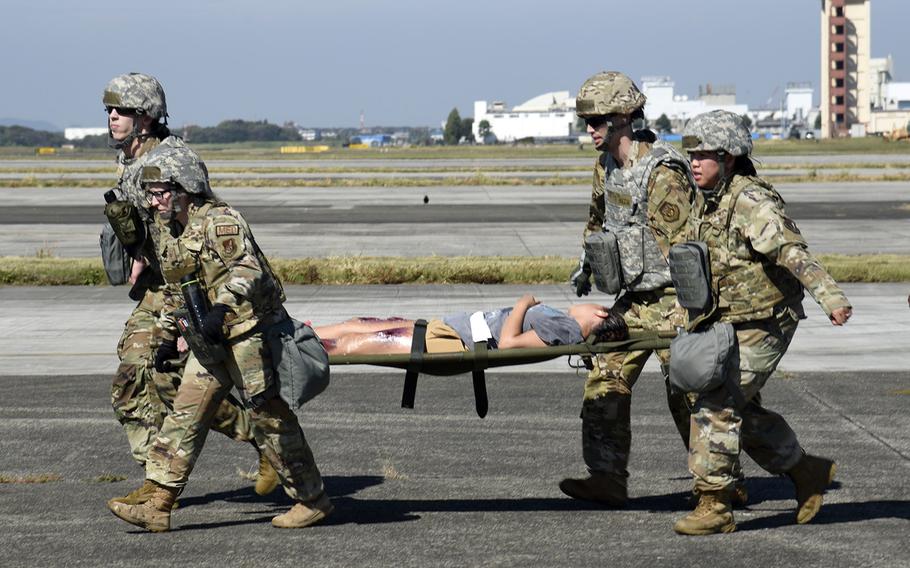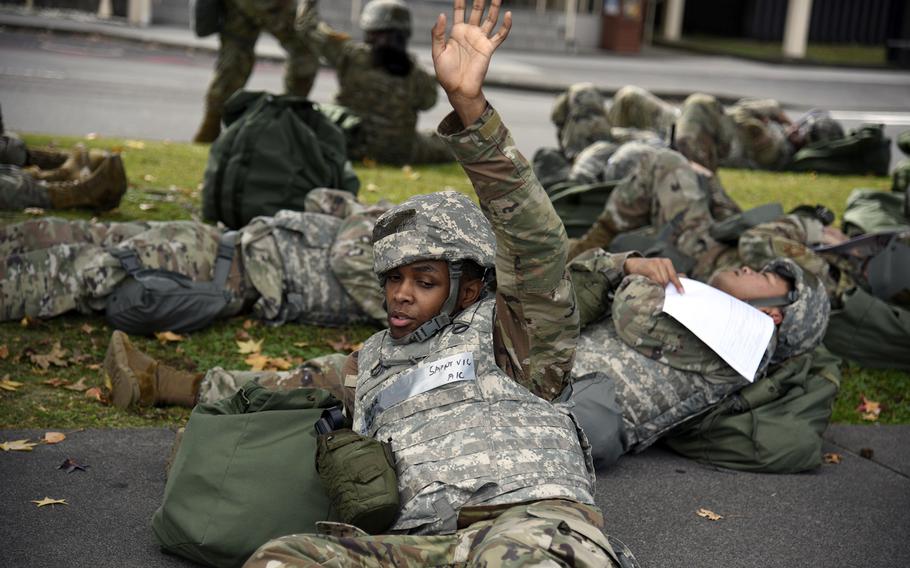
Air Force medics practice treating mass casulaties from an enemy drone strike at Yokota Air Base, Japan, Oct. 20, 2023. (Juan King/Stars and Stripes)
YOKOTA AIR BASE, Japan — An imaginary drone strike had medics scrambling to treat dozens of mock casualties during training Friday at the home of U.S. Forces Japan in western Tokyo.
The exercise happened just a day after drones targeted American troops in the Middle East for the second day in a row, two U.S. officials told The Associated Press. Those strikes follow similar drone attacks last week against U.S. and coalition bases in Iraq.
During Yokota’s training — part of a two-week readiness exercise ending Friday — security forces responded to reports of loud bangs near the on-base Samurai Fitness Center. They found about 40 airmen lying on the ground, clutching cards detailing their blast wounds, ranging from mild to fatal.
Medics sorted them based on severity. The walking wounded were taken to a sports field to await care; others were put on stretchers and loaded into ambulances headed to the base hospital.

Airman 1st Class Edgar Saintvil portrays an airman injured by a drone strike during an exercise at Yokota Air Base, Japan, Oct. 20, 2023. (Juan King/Stars and Stripes)
Four role-players — their limbs made up to simulate severe bloody injuries — were put onto a UH-1 Huey helicopter that flew over Tokyo before landing on a ramp east of Yokota’s runway. Medics arrived on the tarmac and offloaded the patients on stretchers so they could be shuttled to the nearby hospital.
The medevac drill simulated what might happen if the U.S. Navy hospital at Yokosuka Naval Base, about 60 miles to the southeast, became overwhelmed with casualties, said Air Force Capt. Amy Goodnite, a 374th Medical Group administrator who helped plan the exercise.
The training as a whole is designed to test the medics’ ability to respond to an abundance of patients needing care in a crisis, she told Stars and Stripes during the drills.
“Right now, we are working with Yokosuka,” she said of an effort to transport some other mock patients to the naval hospital. “We have a lot of flexibility to provide people a higher level of care.”
Military urgent care centers typically aren’t as well equipped as hospital emergency departments. Transportation time to a Japanese facility can vary according to the patient’s condition, and other delays may result when local hospitals are full.
“We can stabilize and work with our local Japanese hospitals, (but) they would have to accept them,” Goodnite said.
It’s a real-world issue that’s resulted in death in the past. Navy veteran Andrew Hakun, 52, died in February 2021 after suffering a heart attack and waiting hours for transport from Yokota’s clinic to an off-base hospital. Calls were placed to more than 10 Japanese facilities before finding one that would admit him, according to his medical records.